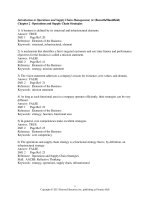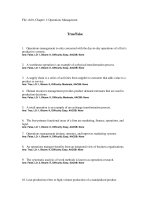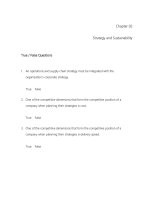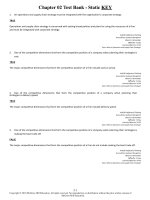Introduction to operations and supply chain management 3e bozarth chapter 12
Bạn đang xem bản rút gọn của tài liệu. Xem và tải ngay bản đầy đủ của tài liệu tại đây (1.76 MB, 57 trang )
Managing Production across the
Supply Chain
Chapter 12
Chapter Objectives
Be able to:
Explain the activities that make up planning and control in a typical
manufacturing environment.
Explain the linkage between sales and operations planning (S&OP) and master
scheduling.
Complete the calculations for the master schedule record and interpret the
results.
Explain the linkage between master scheduling and material requirements
planning (MRP).
Complete the calculations for the MRP record and interpret the results.
Discuss the role of production activity control and vendor order management
and how these functions differ from higher-level planning activities.
Explain how distribution requirements planning (DRP) helps synchronize the
supply chain and complete the calculations for a simple example.
Copyright © 2013 Pearson Education, Inc. publishing as Prentice Hall
12 - 2
Planning and Control
Planning and control – A set of tactical and execution-level
business activities that includes master scheduling, material
requirements planning, and some form of production
activity control and vendor order management.
Copyright © 2013 Pearson Education, Inc. publishing as Prentice Hall
12 - 3
Top-Down Model of Manufacturing
Planning and Control Systems
Figure 12.1
Copyright © 2013 Pearson Education, Inc. publishing as Prentice Hall
12 - 4
Master Scheduling
Master Scheduling – A detailed planning process that
tracks production output and matches this output to
actual customer orders.
Controls the timing and quantity of production for products or
product families.
Serves as the primary interface point for actual customer
orders.
Coordinates forecasted demand and actual orders with
production activity.
Serves as a tool for agreement between marketing and
operations (but at a different level than S&OP).
Copyright © 2013 Pearson Education, Inc. publishing as Prentice Hall
12 - 5
Link between S&OP
and MPS
Month:
Output:
January
200
February
300
March
400
January (weeks)
1
2
3
4
Push Mowers
Self-propelled
Riding
25
25
35
25
25
40
12
13
Copyright © 2013 Pearson Education, Inc. publishing as Prentice Hall
S&OP
MPS
12 - 6
Master Schedule Record
Forecasted demand
Booked orders
Projected inventory levels
Production quantities
Units still available to meet customer needs (Available to
Promise)
Copyright © 2013 Pearson Education, Inc. publishing as Prentice Hall
12 - 7
Forecasted Demand
vs. Booked Orders
Forecasted demand – A company’s best estimate of the
demand in any period.
Booked orders – Confirmed demand for products
Projected Requirements =
Maximum (Forecasted demand, Booked orders)
Copyright © 2013 Pearson Education, Inc. publishing as Prentice Hall
12 - 8
Master Production Schedule (MPS)
Master Production Schedule (MPS) – The amount of product
that will be finished and available for sale at the beginning of
each week.
The MPS quantities drive more detailed planning activities,
such as material requirements planning.
Copyright © 2013 Pearson Education, Inc. publishing as Prentice Hall
12 - 9
Ending Inventory
Projected Ending Inventory – Best estimate of what
inventory levels will look like at the end of each week based
on current information.
EI t = EI t −1 + MPSt − max( Ft , OBt )
Copyright © 2013 Pearson Education, Inc. publishing as Prentice Hall
12 - 10
Available to Promise (ATP)
Available to Promise – A field in the master
schedule record that indicates the number of units
that are available for sale each week, given those
that have already been promised to customers.
Copyright © 2013 Pearson Education, Inc. publishing as Prentice Hall
12 - 11
Available to Promise (ATP)
Calculating ATP for the first week of the master
schedule record:
Copyright © 2013 Pearson Education, Inc. publishing as Prentice Hall
12 - 12
Available to Promise (ATP)
Calculating ATP for any subsequent week in which MPS > 0:
Copyright © 2013 Pearson Education, Inc. publishing as Prentice Hall
12 - 13
Partial Master Schedule Record
(Snowblowers)
Figure 12.4
Copyright © 2013 Pearson Education, Inc. publishing as Prentice Hall
12 - 14
Calculating ATP
Figure 12.5
Copyright © 2013 Pearson Education, Inc. publishing as Prentice Hall
12 - 15
Calculating ATP
Figure 12.6
Copyright © 2013 Pearson Education, Inc. publishing as Prentice Hall
12 - 16
Complete Master Schedule Record
(Snowblowers)
Figure 12.7
Copyright © 2013 Pearson Education, Inc. publishing as Prentice Hall
12 - 17
MPS Example (Backpacks)
Figure 12.8
Now Calculate Projected Ending Inventory and
Available to Promise
Copyright © 2013 Pearson Education, Inc. publishing as Prentice Hall
12 - 18
Calculations (Backpacks)
Calculating Ending Inventory:
Calculating ATP:
Copyright © 2013 Pearson Education, Inc. publishing as Prentice Hall
12 - 19
MPS Example (Backpacks)
with ATP
Figure 12.9
What are the implications of the Master Production Schedule?
Copyright © 2013 Pearson Education, Inc. publishing as Prentice Hall
12 - 20
Planning Horizon
Planning Horizon – The amount of time the master schedule
record or MRP record extends into the future.
The longer the production and supplier lead times, the
longer the planning horizon must be.
Copyright © 2013 Pearson Education, Inc. publishing as Prentice Hall
12 - 21
Material Requirements Planning
Material Requirements Planning (MRP) – A planning process
that translates the master production schedule into planned
orders for the actual parts and components needed to
produce the master schedule items.
Manages dependent demand inventory
Copyright © 2013 Pearson Education, Inc. publishing as Prentice Hall
12 - 22
Material Requirements Planning
MRP is based on:
The bill of material (BOM)
Backward Scheduling
Explosion of the bill of material
Copyright © 2013 Pearson Education, Inc. publishing as Prentice Hall
12 - 23
Bill of Material for Chair
Bill of material (BOM) – A listing of all the
subassemblies, intermediates, parts, and raw
materials that go into a parent assembly showing
the quantity of each required to make an assembly.
© 2010 APICS Dictionary
Figure 12.12
Copyright © 2013 Pearson Education, Inc. publishing as Prentice Hall
12 - 24
Product Structure Tree
Figure 12.13
Planning Lead Time – The time from when a component is ordered
until it arrives and is ready to use.
Copyright © 2013 Pearson Education, Inc. publishing as Prentice Hall
12 - 25









